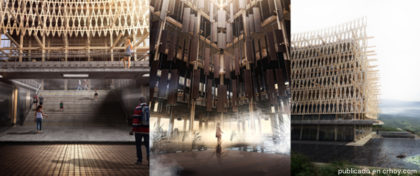
Courtesy
Manuel Antonio National Park is a wilderness area with one of the highest number of visits by national and foreign tourists, due to its rich biological resources. However, all its potential for research and tourism has not been exploited in order to reactivate the economy.
Therefore, Gustavo Cordero López, an Architecture graduate from Universidad Hispanoamericana, devised the project for the construction of a biological station in this point of the Central Pacific, which was presented during the VIII Edition of the International Student Biennial of Architecture, where this concept won four awards in the following categories: Winner of the VIII International Student Biennial of Architecture 2018, Architectural Design not built; Icomadera, awarded by the Costa Rican Institute of Wood, and the most sustainable Climate Change Project awarded by the Costa Rican College of Architects.
According to Jeannette Alvarado, director of the Architecture School of this university, this is the highest award that can be received from a trade association, in this case the CACR in Costa Rica.
This award opens the doors to the winning students because of its great importance. It allows them to complement their professional portfolio and opt for job positions at a national and international level.
The International Biennial of Student Architecture of the College of Architects of Costa Rica (CACR) is a confrontation of university projects and students from any university around the world can participate, as long as they have approved half their credits. The CACR developed an award platform where more than 50 juries from around the world evaluate the projects in a completely transparent and efficient environment, since they only know the technical and graphic information of the project, leaving aside the name of the author, nationality, and university origin,”
assured Alvarado.
The initiative consists in the construction of a research center within the Manuel Antonio National Park with the aim of promoting the study of the species in the area. This building would be
a new tourist spot, where visitors can learn about biodiversity and at the same time boost the economy of the area,”
said Cordero, who added that the construction material must be wood to avoid damages in in the rain forest.
The biological station would be at a height of 100 meters, which is the highest point of the park, so that it can be seen from different places of Quepos and Manuel Antonio.
As for the design, Gustavo Cordero proposes that it be vertical so as not to impact the rainforest and thus
reduce the footprint and affect the site as little as possible to maintain its natural attractiveness; and also one of the main objectives is to work as a large-scale observation tower so the height gives the ideal quality for this purpose.”
Another attraction of the project is the access by a cable car that will connect Manuel Antonio and the station and aims to create a tourist connection circuit in the area. In addition, different trails are proposed to enter on foot.
The creator also proposes a system of suspended ramps that will allow the visitor to explore and observe everything that surrounds the building.
Finally, because of its geographic location and difficult access to services, this building must be “self-sufficient” (to the greatest extent possible), which is why there are different methods to try, for example by using solar photovoltaic panels, and a deposit to store rainwater to be reused within the project.